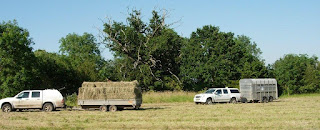28 July 2012
The sweet scent of hay
One of the highlights of hay-making season is the sweet scent of newly mown grass and well-made hay. It is hard to convey the scent on a blog, but perhaps the pictures of my dog Ellie go some way to demonstrate just how good it is!
Haysel
 |
| Mowing at Martin's meadows |
It seems that every hay field in Suffolk was a whirr with cutters, turners and balers. After such a wet June, everyone needed to take advantage of fine weather to harvest hay before the arrival of rain showers forecast for the weekend.
The Suffolk Wildlife Trust meadows were no exception, with all systems go from morning 'til night.
The process started with cutting last Saturday, then turning to allow the hay to 'make', followed by rowing up ready for baling.
 |
| Turning hay at Mickfield |
 |
| Mown hay |
 |
| Baling at Martin's meadows |
The final and perhaps hardest work is loading the bales for carting back to be stored in the barn - but the satisfaction of looking at a stack of sweet smelling hay is some compensation for the aching limbs, as is knowing it is all over until next year!
 |
| Bales awaiting collection |
My thanks must go to everyone who has worked so hard to help get such a lot done in such a short time - a good team prepared to pull together when the weather is right is invaluable for hay making.
 |
| Bales loaded and ready to go off to the barn |
 |
| Last load of the evening
|
7 July 2012
Dyed in the Wool
A few days ago I called in at Martin's Meadows - the Dyer's greenweed (Genista tinctoria) was in full bloom and a buzz with bees.
 A native of old grasslands and green lanes of the boulder clay this member of the pea family really shines out in the meadow. It's rich yellow flowers were once used for dyeing fabric - hence its name.In addition to being an uncommon native plant in Suffolk, Dyer's greenweed was once widely cultivated. The account of the species in Martin Sanford's excellent 'A Flora of Suffolk' (2010) includes reference to Dyer's greenweed being cultivated and harvested in fields near Debenham in the 19th Century, with the resulting harvest going off by the cart load to be used for cloth dyeing in Haverhill.
Having been fairly widely cultivated, it is likely that the current Suffolk population of the plant is a mixture of both the true native and relics of cultivation.
A native of old grasslands and green lanes of the boulder clay this member of the pea family really shines out in the meadow. It's rich yellow flowers were once used for dyeing fabric - hence its name.In addition to being an uncommon native plant in Suffolk, Dyer's greenweed was once widely cultivated. The account of the species in Martin Sanford's excellent 'A Flora of Suffolk' (2010) includes reference to Dyer's greenweed being cultivated and harvested in fields near Debenham in the 19th Century, with the resulting harvest going off by the cart load to be used for cloth dyeing in Haverhill.
Having been fairly widely cultivated, it is likely that the current Suffolk population of the plant is a mixture of both the true native and relics of cultivation.
It only occurs in one meadow at Martin's meadow (the most easterly one), but it does seem to be slowly spreading which is certainly good news for the bees who seem to absolutely love it.
 A native of old grasslands and green lanes of the boulder clay this member of the pea family really shines out in the meadow. It's rich yellow flowers were once used for dyeing fabric - hence its name.In addition to being an uncommon native plant in Suffolk, Dyer's greenweed was once widely cultivated. The account of the species in Martin Sanford's excellent 'A Flora of Suffolk' (2010) includes reference to Dyer's greenweed being cultivated and harvested in fields near Debenham in the 19th Century, with the resulting harvest going off by the cart load to be used for cloth dyeing in Haverhill.
A native of old grasslands and green lanes of the boulder clay this member of the pea family really shines out in the meadow. It's rich yellow flowers were once used for dyeing fabric - hence its name.In addition to being an uncommon native plant in Suffolk, Dyer's greenweed was once widely cultivated. The account of the species in Martin Sanford's excellent 'A Flora of Suffolk' (2010) includes reference to Dyer's greenweed being cultivated and harvested in fields near Debenham in the 19th Century, with the resulting harvest going off by the cart load to be used for cloth dyeing in Haverhill.It only occurs in one meadow at Martin's meadow (the most easterly one), but it does seem to be slowly spreading which is certainly good news for the bees who seem to absolutely love it.
Subscribe to:
Comments (Atom)





